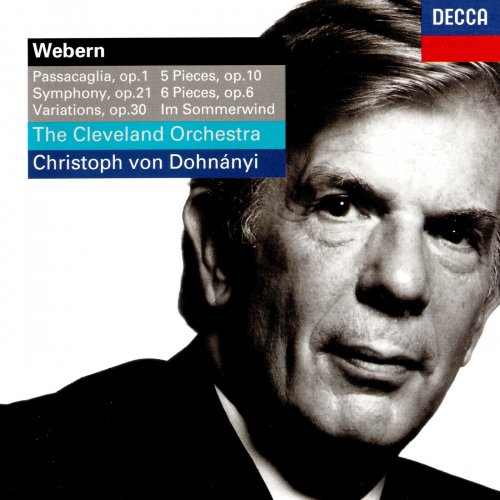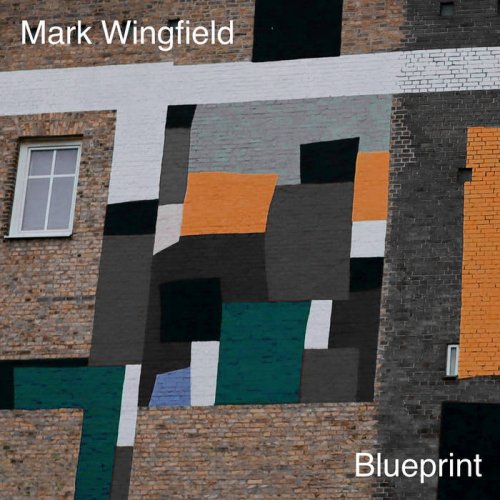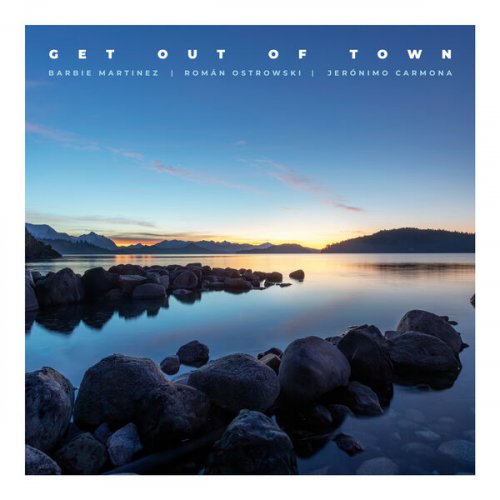Christoph von Dohnányi, The Cleveland Orchestra - Webern: Orchestral Works (1998)

Artist: Christoph von Dohnányi, The Cleveland Orchestra
Title: Webern: Orchestral Works
Year Of Release: 1998
Label: Decca
Genre: Classical
Quality: FLAC (tracks)
Total Time: 01:07:59
Total Size: 244 Mb
WebSite: Album Preview
Tracklist:Title: Webern: Orchestral Works
Year Of Release: 1998
Label: Decca
Genre: Classical
Quality: FLAC (tracks)
Total Time: 01:07:59
Total Size: 244 Mb
WebSite: Album Preview
1. Webern: Passacaglia, Op.1 10:33
Six pieces for orchestra, Op.6 - Revised version (Anton Webern)
2. 1. Etwas bewegt 01:13
3. 2. Bewegt 01:08
4. 3. Zart bewegt 00:53
5. 4. Langsam 05:23
6. 5. Sehr langsam 03:02
7. 6. Zart bewegt 01:59
Symphony, Op.21 (Anton Webern)
8. 1. Ruhig schreitend 06:50
9. 2. Variationen 03:10
5 Pieces for Orchestra, Op.10 (Anton Webern)
10. 1. Sehr ruhig und zart 00:41
11. 2. Lebhaft und zart bewegt 00:30
12. 3. Sehr langsam und äußerst ruhig 01:56
13. 4. Fließend äußerst zart 00:30
14. 5. Sehr fließend 01:02
15. Webern: Variations for Orchestra, Op.30 07:02
Musical Offering, BWV 1079 (Johann Sebastian Bach)
16. Fuga (Ricercata) a 6 voci (Transc. Webern) 07:25
17. Webern: Im Sommerwind 14:42
Performers:
The Cleveland Orchestra
Christoph von Dohnanyi
Webern's "Symphony" (op. 21) is like light passing through a slowly revolving prism, revealing irridescent hues you've never seen before. Following his "Passacaglia" (op. 1), which clarifies but doesn't break with the Romanticism of Brahms, Webern composed four masterful orchestral miniatures. "6 Pieces" (op. 6) and "5 Pieces" (op. 10) are incredibly brief, in the atonal style pioneered by Webern's teacher Schoenberg.
They met with quite different fates -- the "6 Pieces" provoked a "Le Sacre"-style riot at its Vienna premiere in 1913, and Webern fled into hiding. The "5 Pieces" wasn't publicly performed until 1924, at a festival in Zurich, 10 years after it was written. It was widely acclaimed, establishing Webern's international reputation. (Thanks to John Keillor for these details.)
His masterpieces, in my opinion, are the serial works -- "Symphony" (op. 21) and "Variations" (op. 30). Despite their brevity (under 5 minutes and 7 minutes, respectively), these are two of the greatest compositions of the 20th century. Webern here developed Schoenberg's 12 tone rows into something exquisite, more beautiful than anything his teacher created. These works, along with the String Trio and Quartet (op. 20 and op. 28), became the main influence on the "Darmstadt School" of the 1950s (Boulez, Stockhausen, Berio, Nono, Ligeti, & Co.).
This disc is one of two that collect Webern's orchestral works. I give Dohnanyi and Cleveland a slight edge over Sinopoli with the Staatskapelle Dresden on Teldec , but they are both suberb recordings. Dohnanyi achieves a smooth, homogenous texture, whereas Sinopoli creates wider dynamics and greater separation of instruments. Dohnanyi's Webern is abstract, cold and restrained, while Sinopoli's Webern is more emotional, warmer and lusher by comparison (not by comparison to Mahler!).
The two discs contain the same material, with one exception -- Dohnanyi includes Webern's arrangement of Bach's "Fuga ricercata a 6," a fascinating exercise in pointillism, breaking the music into consituent cells. Sinopoli includes the "Concerto" (op. 24) for 9 instruments, a Bach-influenced composition. On recording quality, the Teldec is superior.
The Dohnanyi booklet includes a great photo of Webern, with a tragic expression absolutely apropos to the music, but the cover is a photo of Dohnanyi, and I detest this tradition in classical music. The Sinopoli booklet features instead a photo of a haunting sculpture by the British sculptor Andy Goldsworthy, and keeps the photo of Sinopoli inside, and so it wins the graphic design competition!
They met with quite different fates -- the "6 Pieces" provoked a "Le Sacre"-style riot at its Vienna premiere in 1913, and Webern fled into hiding. The "5 Pieces" wasn't publicly performed until 1924, at a festival in Zurich, 10 years after it was written. It was widely acclaimed, establishing Webern's international reputation. (Thanks to John Keillor for these details.)
His masterpieces, in my opinion, are the serial works -- "Symphony" (op. 21) and "Variations" (op. 30). Despite their brevity (under 5 minutes and 7 minutes, respectively), these are two of the greatest compositions of the 20th century. Webern here developed Schoenberg's 12 tone rows into something exquisite, more beautiful than anything his teacher created. These works, along with the String Trio and Quartet (op. 20 and op. 28), became the main influence on the "Darmstadt School" of the 1950s (Boulez, Stockhausen, Berio, Nono, Ligeti, & Co.).
This disc is one of two that collect Webern's orchestral works. I give Dohnanyi and Cleveland a slight edge over Sinopoli with the Staatskapelle Dresden on Teldec , but they are both suberb recordings. Dohnanyi achieves a smooth, homogenous texture, whereas Sinopoli creates wider dynamics and greater separation of instruments. Dohnanyi's Webern is abstract, cold and restrained, while Sinopoli's Webern is more emotional, warmer and lusher by comparison (not by comparison to Mahler!).
The two discs contain the same material, with one exception -- Dohnanyi includes Webern's arrangement of Bach's "Fuga ricercata a 6," a fascinating exercise in pointillism, breaking the music into consituent cells. Sinopoli includes the "Concerto" (op. 24) for 9 instruments, a Bach-influenced composition. On recording quality, the Teldec is superior.
The Dohnanyi booklet includes a great photo of Webern, with a tragic expression absolutely apropos to the music, but the cover is a photo of Dohnanyi, and I detest this tradition in classical music. The Sinopoli booklet features instead a photo of a haunting sculpture by the British sculptor Andy Goldsworthy, and keeps the photo of Sinopoli inside, and so it wins the graphic design competition!

![Dave Bainbridge - ON THE EDGE (OF WHAT COULD BE) (2025) [Hi-Res] Dave Bainbridge - ON THE EDGE (OF WHAT COULD BE) (2025) [Hi-Res]](https://img.israbox.com/img/2025-12/18/7l4en830rpyaxdtr7izc3qrx6.jpg)
![Clifton Chenier - Live (1972) [Hi-Res] Clifton Chenier - Live (1972) [Hi-Res]](https://img.israbox.com/img/2025-12/20/ho8gau8m3me6gvkdop8e21lq3.jpg)
![Frank Sinatra, Count Basie - It Might As Well Be Swing (1964) [2021 SACD] Frank Sinatra, Count Basie - It Might As Well Be Swing (1964) [2021 SACD]](https://www.dibpic.com/uploads/posts/2025-12/1766090910_scan-1.jpeg)



![Xavi Torres - Amsterdam Magic (2025) [Hi-Res] Xavi Torres - Amsterdam Magic (2025) [Hi-Res]](https://www.dibpic.com/uploads/posts/2025-12/1766061682_cover.jpg)
